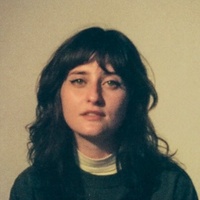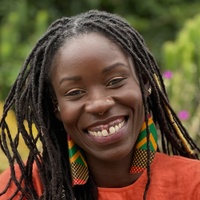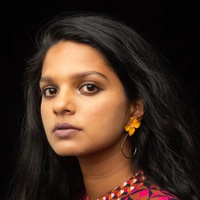As told to Arielle Gordon, 2179 words.
Tags: Music, Video, Multi-tasking, Process, Identity, Day jobs.
On finding inspiration in limitations
Filmmaker and musician Nina Ljeti on bringing a creative vision to corporate work, coming to set ready for anything, and seeking out constraints that excite you.With the music video for Phoebe Bridgers’ “Kyoto,” you had the constraint of COVID and lockdowns, but I think the result ended up being much more interesting maybe than something that you could’ve done on the ground. Do you feel like constraints help you become more creative, or do you prefer to work without them?
I think that there’s an argument to be made for both, obviously. I think every director dreams of the Kubrick opportunity to have 500 shoot days and try everything that you want, even though I’m sure he had his own limitations. If you understand the artist, if you understand the music, if you know what you’re doing, and then you arrive on set and you’re just working within the space that you prepare yourself for, a lot of really interesting things can happen.
The plan with “Kyoto” was to go to Tokyo, but I really thought it was better without it, ultimately. If you are open to that, then you can find new ways of telling a story. That’s happened to me on pretty much every project I’ve ever worked on. You’re working with limitations, lack of time, or lack of money. I think it’s a cop out to say that you can’t do something with X amount of money or X amount of time. There’s always something you could be doing.
Are there any tips or tricks you have when you’re at the outset of planning to cut costs, cut set days? Is there a way you are able to manage a smaller budget when you’re working with music video budgets?
The only advice I have is to prepare yourself as a director and know as much as you can going in, so that you can adjust in real time. I’m working on projects all the time where you start with a set of limitations and then you build your shot list. Then you arrive on set, and you again have to reassess. The best thing that I can say is learn and understand your work as best you can, so you can just go on set and make it happen. If you know what you’re doing and you have to pivot, it’s not so scary. When you have to pivot and you’re not quite confident in the process, then it can cause panic and chaos.
I’m working on a project right now, an eight-page horror thriller short film. We shot it in 12 hours, 60 shots, 60 setups. You go in like, “I have to rehearse what I’m doing. I have to know every fucking nook, cranny, corner, every possibility of what might go down. If there’s a lighting delay in this scene, what can we do to make up for it?” Then on set, when cuts have to happen, you can figure it out. Worst case scenario, the editor will have to deal with it.
How do you negotiate creative control when you’re working with other creatives? When you’re working with a musician who wants to make a music video, for example.
I’m not opposed to collaborating with an artist. I think there’s something nice about that. I have gotten to a point in my career where people know my style, so they’re reaching out to me for me to put my mark on a piece of work. For one of my favorite videos, Alexandra Savior’s “Howl,” she came to me and had a rough idea, and we worked on it together. It’s exciting because you also have the opportunity to learn other points of view as a director. I’m also a storyteller, so understanding how other people feel about their music, and how they want to express themselves is exciting to me.
Do you ever approach artists that you want to work with that you like their music, or has it mostly been the other way around?
I’ve actually never approached anybody to work with them. Maybe I should. I think up until recently, I’ve always been too shy, but my New Year’s resolution is to not be shy anymore.
Shyness is interesting. Is that something that you battle with as a director and as the front person in your band Kills Birds?
No. When I’m on set or I’m on stage, there’s a different version of me that takes over. But when I’m off stage, I think my insecurities come through. As a director, I’ve really started to find myself in a way that I feel good about artistically. In the past as an artist, I always struggled with my worth. Will anybody care to hear my idea? Is my idea good enough? I think if you don’t have that security, that belief in yourself and what you have to say, it’s really hard to reach out to an artist and ask them to work with you. I wrote a feature film about a band, and I’m hell-bent on making it happen. There’s all these different formulas in my mind of what I must do to get people to listen to me. I think you have to be loud, and I used to be really against that. I was always like, “It’s so pathetic and sad,” but it’s actually the opposite. I think it’s really cool if you can believe in yourself and just let people know, but not be a dick about it obviously.
I really love your style. It’s very intimate. I always feel like a fly on the wall in your music videos.
Well, I think it’s really interesting that you say that I have a distinct style, because actually, I was having a conversation about this with my boyfriend. I was like, “I would not be able to define my own style at all.” Nadia Lee Cohen is a really good example of an artist who has such a distinct and exciting voice. You know one of her pieces when you see it, and I don’t know if it’s just because I can’t look at myself in an objective way, but I was like, “Who am I as a director? Would somebody know?”
I would say I have my job at Vogue for that reason that you mentioned, to expand and do more commercial things, work with celebrities, do fashion videos and things like that, so you can generate a more commercial style. I feel like an artist nowadays has to have a bit of both in order to make a living.
Your work for Vogue does feel, to me at least, very deeply human, which is not to be taken for granted in any corporate work. How do you negotiate your own style or your own creativity when you’re working within a corporate entity?
It took me a long time to win their trust and to feel comfortable enough within that ecosystem to fight for what I believed in. When you start working at a legacy brand like that, you feel like you need to stick with their established visual language. Luckily, I work with people who saw that I had my own vision and let me embrace it. It allowed me to really revamp the structure for something like their “Getting Ready With” series and to pitch the multimedia videos that we’ve been doing.
I’m curious about how technology has impacted your style. I love that you use 16mm for your films, and obviously there’s risks and limitations to that as well. How do you decide what to use for each project?
In the past, my decision to use analog formats was just out of necessity. “Well, we only have $500 to make this music video, so what can we use to make it?” It was more interesting than using an iPhone. Some of my more well-known music videos came from limitations. That Phoebe Bridgers video, for example. “We have this much time and this much money, what should we do? Let’s use a VHS camera.” But then that stopped exciting me. The challenge is, how can you experiment with different kinds of technology within the same limitations?
I don’t think that Jeremy Allen White video for Vogue would’ve made as much of an impact without the Polaroids we had and without the MiniDV footage, and without him holding the MiniDV camera. How can you make people feel more involved and keep their attention longer, but then also at the same time, strengthen your story? The Polaroids created that sense of intimacy of this person sitting with you and talking to you.
Do you shift your approach at all when you’re directing non-professional actors, like musicians?
I do, actually. I try not to give as much direction. I try to use their abilities to their advantage. I think comedic concepts are really good for that. “1980s Horror Film” by Wallows is an example. One of the band members, my boyfriend [Cole Preston], is a non-actor. How can we use his natural resting face and his persona to help propel the story forward? I try to avoid saying, “I need you to feel this way,” because it just doesn’t work. Some people aren’t trained in that, and I think that’s okay. I think you can get good things from anybody, really.
How has your experience as an immigrant and a child of immigrants impacted your creative output?
Pretty massively. Coming from Bosnia and having my family flee the war obviously ingrained this sense of duty that my parents never instilled in me, but that you can’t help but feel. I can’t help but feel I need to prove to my parents that their sacrifice was worth it. I want to be able to support my parents one day. I want to be able to give them peace and freedom because of what they did for me. My dad risking his life to save us. Those are things that I wake up every morning and think about.
Can you tell me about your upcoming film about a musician? I’m curious if that’s about Kills Birds or if it’s about a fictional band?
Well, it’s definitely inspired by Kills Birds and a tour that we went on. There’s some elements in there of our personal experience as a band post-COVID navigating the music industry. Not only how difficult it is to earn a living in the music industry, but the lack of mental health services and financial support available to artists in the beginning stages of their career. It can be very toxic and damaging to a young band that comes in with the best intentions, but finds that they’re constantly having to pay to play, to put their physical and mental health on the back burner to try to get something that used to be more attainable. Even if you weren’t a famous artist, you could make some semblance of a living doing it. So at its core, it’s very much about that.
The idea started in 2022. Kills Birds was on tour with the Foo Fighters around the time that Taylor Hawkins died. Seeing that tragedy unfold coupled with another tragedy that happened close to us inspired me to tell this story. But on the surface, it’s a horror film. It’s about a band that’s traveling across the country when its lead singer starts noticing somebody that’s following them wherever they go. I’d like to think of it as less of a horror actually, and more of a fly on the wall commentary about how shitty tour is. But there’s horror sequences in there.
How much do you think about genre when you’re writing a film?
Not at all, honestly. The film we’re working on now has horror elements, but I’m always trying to find new ways of saying something. In my feature script, it was an experiment: How can I create suspense in an atypical way? So the first 30 pages, for example, is very unassuming, whereas a lot of horror scripts might start establishing the unease very early on. I wanted to create a road movie that is turned on its head suddenly.
Do you feel like it’s ever possible to take a break, with so many projects you’re working on?
I don’t really want to take a break from work. To me, writing and thinking and ruminating on ideas, that’s how I relax. My boyfriend is always like, “Let’s just play Fortnite. Let’s just chill. Let’s play Baldur’s Gate 3 and let our worries melt away.” That’s nice for a few hours, but I’m always in the back of my mind thinking about what I want to do next. I live and breathe that.
Nina Ljeti Recommends:
Read House of Leaves by Mark Z. Danielewski
Listen to the new MGMT album Loss of Life
Please play Baldur’s Gate 3 and take great care when making your character
Watch Quo Vadis, Aida? a film by Bosnian director Jasmila Zbanic




